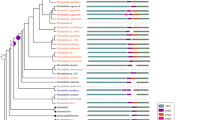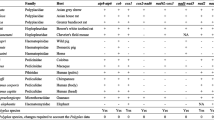Summary
Analysis of mitochondrial DNAs (mtDNAs) from parthenogenetic lizards of theHeteronotia binoei complex with restriction enzymes revealed an ∼5-kb addition present in all 77 individuals. Cleavage site mapping suggested the presence of a direct tandem duplication spanning the 16S and 12S rRNA genes, the control region and most, if not all, of the gene for the subunit 1 of NADH dehydrogenase (ND1). The location of the duplication was confirmed by Southern hybridization. A restriction enzyme survey provided evidence for modifications to each copy of the duplicated sequence, including four large deletions. Each gene affected by a deletion was complemented by an intact version in the other copy of the sequence, although for one gene the functional copy was heteroplasmic for another deletion. Sequencing of a fragment from one copy of the duplication which encompassed the tRNAleu(UUR) and parts of the 16S rRNA and ND1 genes, revealed mutations expected to disrupt function. Thus, evolution subsequent to the duplication event has resulted in mitochondrial pseudogenes. The presence of duplications in all of these parthenogens, but not among representatives of their maternal sexual ancestors, suggests that the duplications arose in the parthenogenetic form. This provides the second instance inH. binoei of mtDNA duplication associated with the transition from sexual to parthenogenetic reproduction. The increased incidence of duplications in parthenogenetic lizards may be caused by errors in mtDNA replication due to either polyploidy or hybridity of their nuclear genomes.
Similar content being viewed by others
References
Attardi G (1985) Animal mitochondria DNA: an extreme of genetic economy. Int Rev Cytol 93:93–145
Boursot P Yonekawa H, Bonhomme F (1987) Heteroplasmy in mice with a deletion of a large coding region of mitochondrial DNA Mol Biol Evol 4:46–55
Brown WM (1985) The mitocondrial genome of animals. In: MacIntyre RJ (ed) Molecular evolutionary genetics. Plenum, New York, pp 95–130
Cantatore P, Gadaleta MN, Roberti M, Saccone C, Wilson AC (1987) Duplication and remoulding of tRNA genes during the evolutionary rearrangement of mitochondrial genomes. Nature 329:853–855
Carr SM, Brothers AJ, Wilson AC (1987) Evolutionary inferences from restriction maps of mitochondrial DNA from nine taxa ofXenopus frogs. Evolution 41:176–190
Chang DD, Clayton DA (1987) A mitochondrial RNA processing activity contains nuclearly encoded RNA. Science 235:1178–1184
Christianson TW, Clayton DA (1988) A tridecamer sequence supports human mitochondrial RNA 3′-end formation in vitro. Mol Cell Biol 8:4502–4509
Chung CT, Niemela SL, Miller RH (1989) One step preparation of competentEscherichia coli: transformation and storage of bacterial cells in the same solution. Proc Natl Acad Sci USA 86:2172–2175
Clark-Walker GD (1985) Basis of diversity in mitochondrial DNAs. In: Cavalier Smith T (ed), The evolution of genome size. Wiley and Sons, Chichester NY, pp 277–297
Clary DO, Wolstenholme DR (1985) The mitochondrial DNA molecule ofDrosophila yakuba: nucleotide sequence, gene organization, and genetic code. J Mol Evol 22:252–271
Clayton DA (1982) Replication of animal mitochondrial DNA. Cell 28:693–705
Clayton DA (1984) Transcription of the mammalian mitochondrial genome. Annu Rev Biochem 53:573–579
Del Sal G, Manfioletti G, Schneider C (1988) A one tube plasmid DNA mini-preparation suitable for sequencing. Nucleic Acids Res 16:9878
Desjardins P, Morais R (1990) Sequence and gene organization of chicken mitochondrial genome. J Mol Biol 212:599–634
Dowling TE, Moritz C, Palmer JD (1990) Nucleic acids II: Restriction site analysis. In: Hillis DM, Moritz C (eds) Molecular systematics. Sinauer, Sunderland MA
Dubin DT, Hsu-Chen CC, Tillotsen LE (1986) Mosquito mitochondrial transfer tRNAs for valine, glycine and glutamate: RNA and gene sequences and vicinal genome organization. Curr Genet 10:701–707
Garey JR, Wolstenholme DR (1989) Platyhelminth mitochondrial DNA: evidence for early evolutionary origin of a tRNAser(AGN) that contains a dihydrouridine arm replacement loop, and of serine-specifying AGA and AGG codons. J Mol Evol 28:374–387
Goto Y-I, Nonaka I, Horai S (1990) A mutation in the tRNALeu(UUR) gene associated with the MELAS subgroup of mitochondrial encephalomyopathies. Nature 348:651–653
Hyman BC, Beck JL, Weiss KC (1988) Sequence amplification and gene rearrangement in parasitic nematode mitochondrial DNA. Genetics 120:707–712
Jacobs HT, Asakawa S, Araki T, Miura K, Smith MJ, Watanabe K (1989) Conserved tRNA cluster in starfish mitochondrial DNA. Curr Genet 15:193–206
Johansen S, Guddal PH, Johansen T (1990) Organization of the mitochondrial genome of Atlantic cod,Gadus morhua. Nucleic Acids Res 18:411–419
Kessing B, Martin A, Croom H, Palumbi S (1989) The simple fool's guide to PCR. Miscellaneous Publications of the department of Zoology, University of Hawaii, Honolulu
Kocher TD, Thomas WK, Meyer A, Edwards SV, Paabo S, Villablanca FX (1989) Dynamics of mitochondrial DNA evolution in animals: amplification and sequencing with conserved primers. Proc Natl Acad Sci USA 86:1–5
Li W-H, Luo C-C, Wu C-I (1985) Evolution of DNA sequences. In: MacIntyre RJ (ed) Molecular evolutionary genetics. Plenum, New York, pp 1–94
Moritz C (1983) Parthenogenesis in the endemic Australian lizardHeteronotia binoei (Gekkonidae). Chromosoma 89:151–162
Moritz C (1991a) Evolutionary dynamics of mitochondrial DNA duplications in parthenogenetic geckos,Heteronotia binoei. Genetics (in press)
Mortiz C (1991b) The origin and evolution of parthenogenesis inHeteronotia binoei (Gekkonidae): evidence for recent and localized origins of widespread clones. Genetics (in press)
Moritz C, Brown WM (1987) Tandem duplications in animal mitochondrial DNAs: variation in incidence and gene content among lizards. Proc Natl Acad Sci USA 84:7183–7187
Mortiz C, Dowling TE, Brown WM (1987) Evolution of animal mitochondrial DNA: relevance for population biology and systematics. Annu Rev Ecol Syst 18:269–292
Nei M, Tajima F (1983) Maximum likelihood estimation of the number of nucleotide substitutions from restriction sites data. Genetics 105:207–217
Poulton J, Deadman ME, Gardiner RM (1989) Tandem direct duplication of mitochondrial DNA in mitochondrial myopathy: analysis of nucleotide sequence and tissue distribution. Nucleic Acids Res 17:10223–10229
Rand DM, Harrison RG (1989) Molecular population genetics of mtDNA size variation in crickets. Genetics 121:551–569
Roe BA, Ma D-P, Wilson RK, Wong JF-H (1985) The complete nucleotide sequence of theXenopus laevis mitochondrial genome. J Biol Chem 260:9759–9774
Sambrook J, Fritsch EF, Maniatis T (1989) Molecular cloning: a laboratory manual, ed 2. Cold Spring Harbor Laboratory Press, Cold Spring Harbor NY
Sanger FS, Nicklen S, Coulson AR (1977) DNA sequencing with chain-terminating inhibitors. Proc Natl Acad Sci USA 74:5463–5467
Sederoff RR (1984) Structural variation in mitochondrial DNA. Adv Genet 22:1–108
Smith MJ, Banfield DK, Doteval K, Gorski S, Kowbel DJ (1990) Nucleotide sequence of nine-protein coding genes and 22 tRNAs in the mitochondrial DNA of the sea starPisaster ochraceus. J Mol Evol 31:195–204
Swofford (1987) Phylogenetic analysis using parsimony, version 2.4. Illinois Natural History Survey
Tabor S, Richardson CC (1987) DNA sequence analysis with a modified bacteriophage T7 DNA polymerase. Proc Natl Acad Sci USA 84:4767
Vieira J, Messing J (1987) Production of single-stranded plasmid DNA. Methods Enzymol 153:3
Vrijenhoek RC, Dawley RM, Cole CJ, Bogart JP (1989) A list of the known unisexual vertebrates. In: Dawley RM, Bogart JP (eds) Evolution and ecology of unisexual vertebrates. Bulletin 466. New York State Museum, Albany NY, pp 19–23
Wallace DC (1982) Structure and evolution of organelle genomes. Microbiol Rev 46:208–240
Wallace DC (1989) Mitochondrial DNA mutations and neuromuscular disease. Trends Genet 5:9–13
Wallis GP (1987) Mitochondrial DNA insertion polymorphism and germ line heteroplasmy in theTriturus cristatus complex. Heredity 58:229–238
Zeviani M, Servidei S, Gellera C, Bertini E, Dimauro S, Didonato S (1989) An autosomal dominant disorder with multiple deletions of mitochondrial DNA starting at the D-loop region. Nature 339:309–311
Author information
Authors and Affiliations
Rights and permissions
About this article
Cite this article
Zevering, C.E., Moritz, C., Heideman, A. et al. Parallel origins of duplications and the formation of pseudogenes in mitochondrial DNA from parthenogenetic lizards (Heteronotia binoei; Gekkonidae). J Mol Evol 33, 431–441 (1991). https://doi.org/10.1007/BF02103135
Received:
Accepted:
Published:
Issue Date:
DOI: https://doi.org/10.1007/BF02103135




